Page Not Found
Page not found. Your pixels are in another canvas.
A list of all the posts and pages found on the site. For you robots out there is an XML version available for digesting as well.
Page not found. Your pixels are in another canvas.
About me
This is a page not in th emain menu
Published:
Some thoughts on using ASR after bandpass filtering as a potential good pipeline for a low-density EEG system like Muse (4 ch). Developed for students to quick prototype with Muse for a class I am guest lecturing for. Unlike denser systems, we cannot do ICA on Low-density systems like muse. Rejecting eye blinks and infrequent bursts by visual inspection might be challenging for long recordings. An appropriate threshold can minimize these artifacts while preserving clean signals. I cannot over-emphasis this enough. Selecting the right threshold is critical here!!! The default parameter for ASR is very conservative and removes too much data. This is variable depending on your data distribution and the nature of the study. Always check the data and perform sanity checks and do not go by default parameters.
The figure demonstraets a section of EEG during an eyes closed and eyes open condition. Here, the blinks when present are removed by ASR whereas the section during eyes closed during which there are no blinks, the data is retained. It shows how a carefully selected threshold can remove blinks while not rejecting cleaner part (section without blinks are retained). 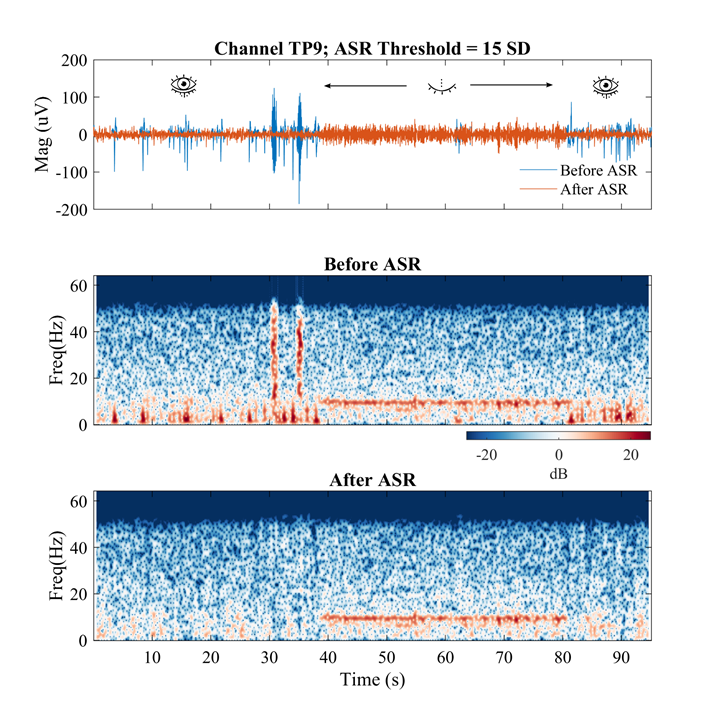
Here it is very critical that we select the threshold well. For e.g. a conservative threshod of say 5 standard deviation distorts/ reconstructs even the cleaner part of the data 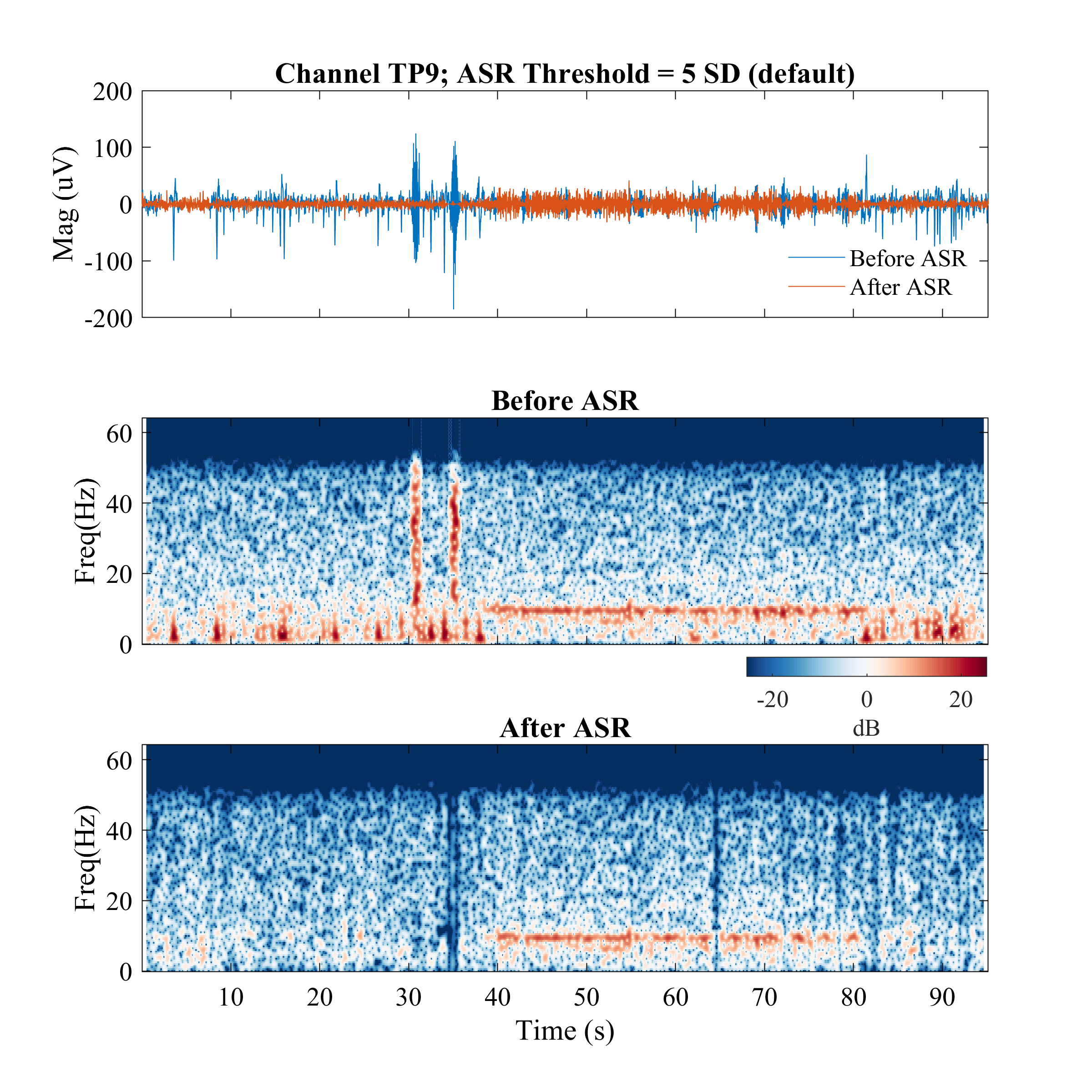
A relatively high threshold on the other hand fails to remove the noisy component as well. Finding the right balance is key. Sometimes, there would not be enough components to reconstruct corrupt PC and ASR flattens the data. Make sure to remove these segments from later stage 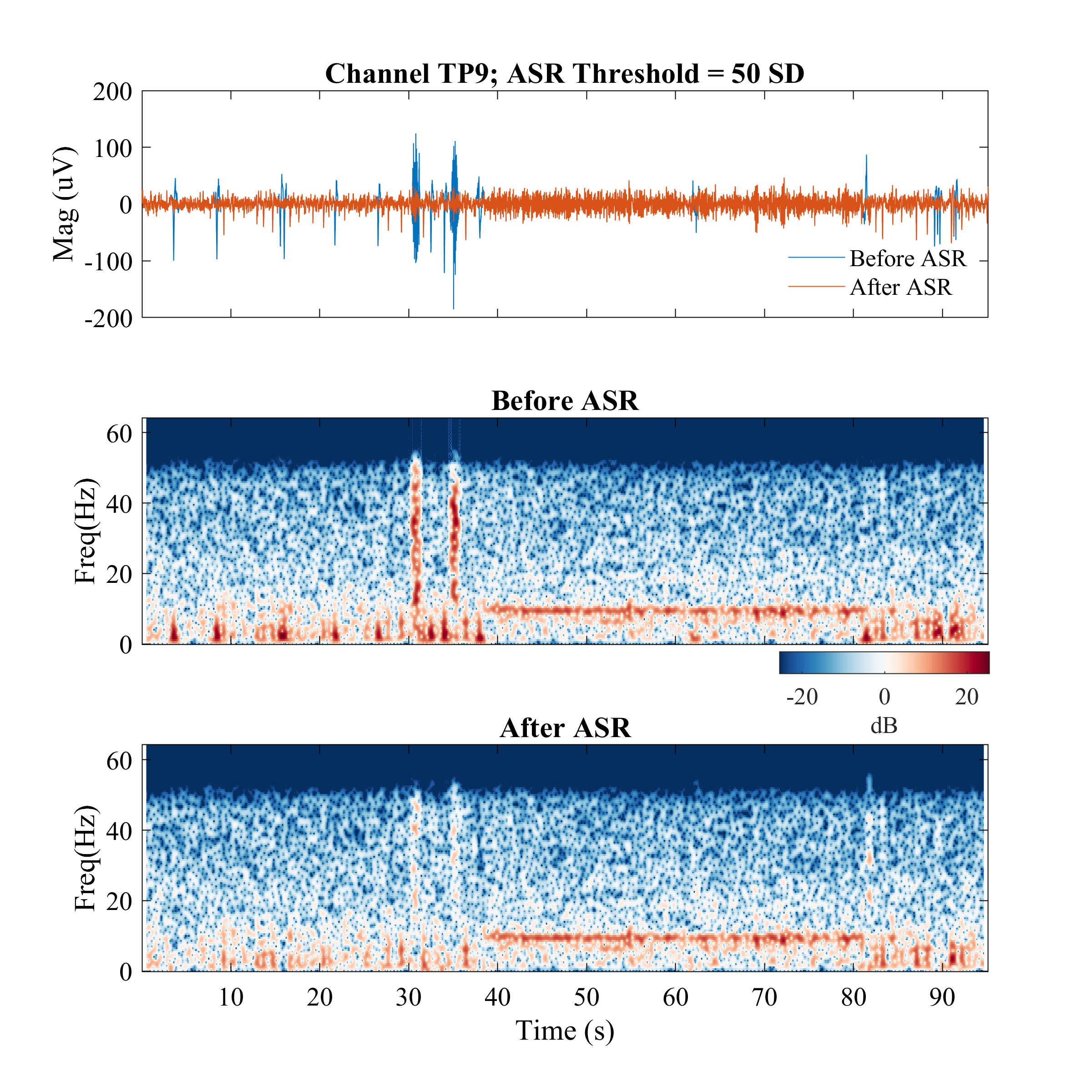
The default of value is never a good value. Make sure the value is ideal for your data, do empirical visual testing to select an ideal threshold for your data 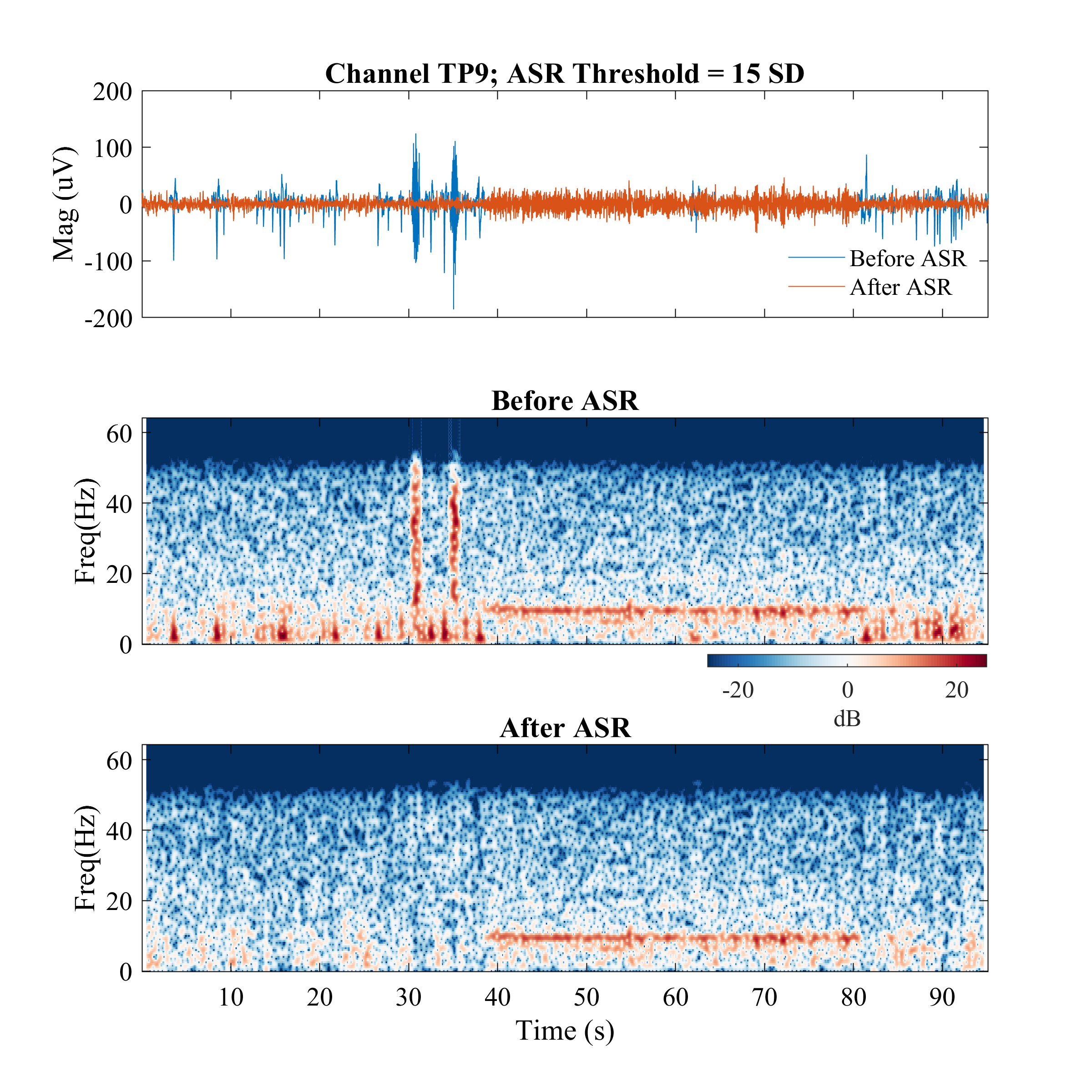 **An important point to keep in mind is that ASR is based on Principal component analysis. A concern is there is 4 ch only and so 4 PCs. The reconstruction will be lossy and not ideal. Thread is not intended to say the method is error-proof, but an option to consider & to emphasize not to go with default:)
**An important point to keep in mind is that ASR is based on Principal component analysis. A concern is there is 4 ch only and so 4 PCs. The reconstruction will be lossy and not ideal. Thread is not intended to say the method is error-proof, but an option to consider & to emphasize not to go with default:)
Published:
EEG measures the electrical activity at a sensor relative to the reference & ground electrode. This causes issues in comparing absolute power between conditions &/participants as impedance differences can cause broadband shift in power. Relative power is often used as a substitute of absolute power as it supposedly normalizes w.r.t. the total power in the window of interest. However, using relative power to compare different conditions can cause spurious differences due to the nature of computation and this code is used to simulate a set of PSDs to evaluate when they fail and show how flattened PSD is a better alternative to quantify changes in multiple bands. 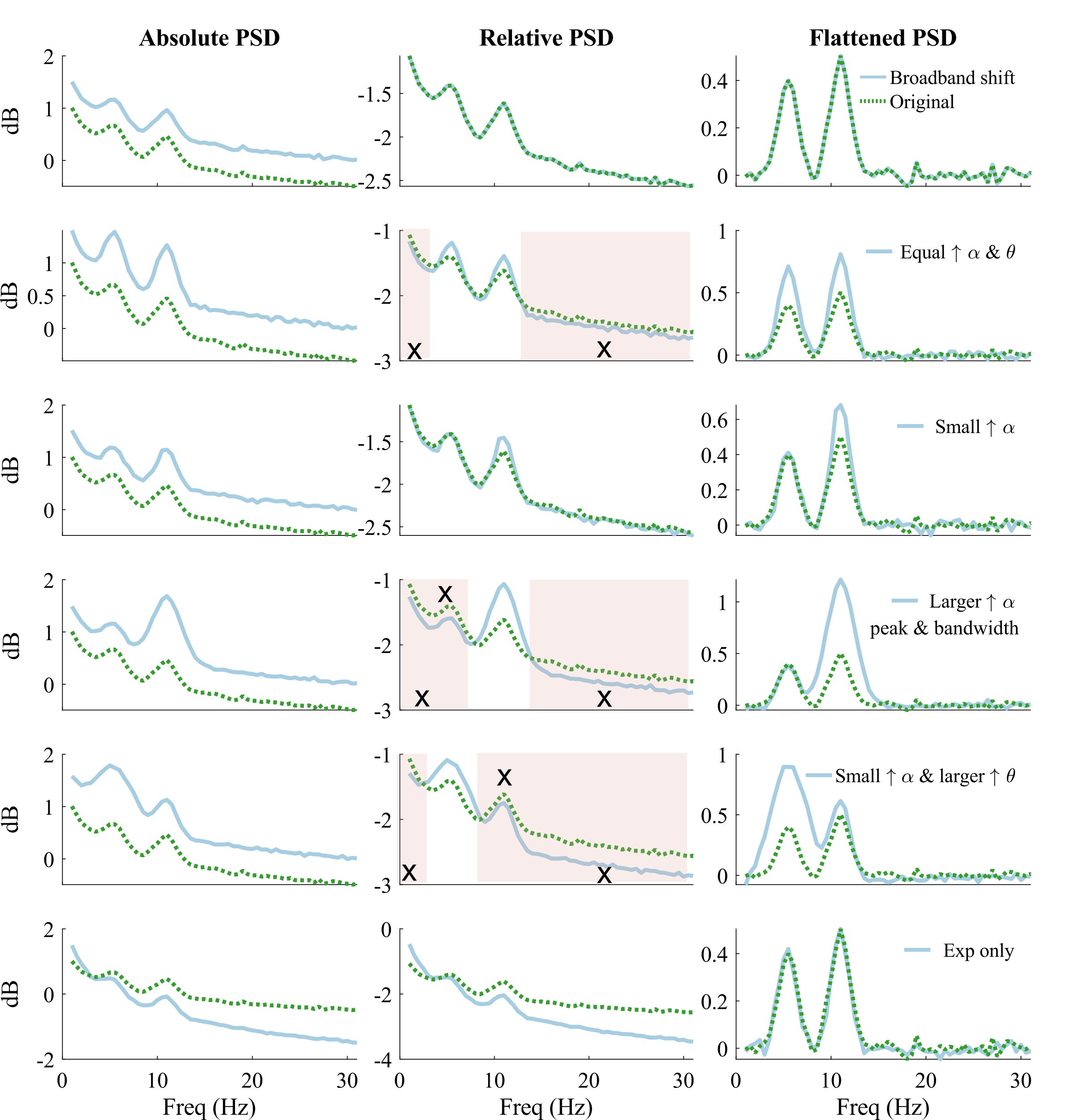
In general, relative power is better when reporting which band has the highest power difference. Comparing multiple bands can lead to spurious differences due to the nature of computation. Periodic power is a much more robust alternative to quantify multi-band differences.
If power increase in two bands equally, their relationship in relative power is preserved in these bands but the power in other bands gets reduced even though in the original signal they are the same. Periodic power captures these differences well. Using absolute power on the other hand can cause artificial differences even due to simple broadband power differences which can also be due to non-physiological origins such as impedance differences. Either relative power or parameterized PSD helps with it.

If the power increase is small and limited to only one band, the differences are not distorted by neither relative power nor periodic power

However, the same band power if increased more, after a point it starts distorting the rest of the PSD and the relationship will be altered. As can be seen, the rest of the band power gets artificially increased and can lead to spurious reporting.

When multiple bands increase but one (theta) is much bigger than the other (alpha), not even the increase in alpha power will be represented correctly (the relationship is flipped).

Published:
Weekend random thoughts on practices/views I wished we emphasized more as a community. Sharing in case someone benefits
1) Passion is critical in life as it makes the journey fun, but realize that your passion is also limited to things you are exposed to. So it is ok for it to evolve with time. Explore many things early in your career & let your passion drive the journey
2) Exposure is key & plays a huge part in you succeeding at things. If you are first in your family at doing something, it will be harder for you. You might not have the right contact or info at the right time. Your journey is unique, so work on that. Dont be disheartened by someone else's success
3) Normalize failures & encourage growth from them. Realize that the faster you fail at something, the quicker you will learn to master that situation. Let's strive to develop an environment that allows people to become vulnerable & face their fears
4) There will always be people who are better than you & that's ok. Know that it is a process, & have a larger vision. At each moment, take the next step in the direction that gets you closer to realizing it & enjoy the journey
5) Schools shifts their focus from training us to be better test-takers to creating an environment that promotes us to be curious & collaborative
Short description of portfolio item number 1
I am a Data Scientist II at Alto Neuroscience. I use machine learning and signal processing tool to to predict clinical response and identify patients who are most likely to benefit from our drug candidates using their brain activity meassured using electroencephalography (EEG). I obtained my doctoral degree from the Department of Electrical and Computer Engineering at the University of Houston in 2021. Under the supervision of Dr. Jose Contreras Vidal, I worked in the Non-Invasive Brain-Machine Interface Systems Lab as part of the BRAIN Center (NSF IUCRC). My thesis was on Developing Explainable Deep Learning Models Using EEG for Brain Machine Interface Systems.
My broader research focused on developing different engineering tools for analyzing non-invasive electrophysiological data, mainly involving EEG. My expertise lies in developing machine learning models and signal processing tools to study EEG. Even though my thesis is centered around using deep learning models, I believe that deep learning is not the answer to all questions and many questions are best answered by classical signal processing and machine learning approaches. Finding appropriate use-case for classical vs more advanced modeling algorithms will be key in deploying sucesssful products.
I have a diverse portfolio of projects covering areas such as: a) Spearheaded the design and implementation of cutting‐edge machine learning pipelines tailored specifi‐ cally for precision medicine in psychiatry. Achieved measurable success in accurately stratifying individuals with depression and predicting their response to various medications, thereby optimizing treatment outcomes and patient care b) Expertly integrated and optimized diverse EEG features to enhance the predictive power of machine learn‐ ing models. This meticulous optimization process resulted in the development of highly resilient and reli‐ able models, capable of discerning subtle patterns crucial for personalized treatment approaches in psychiatry. c) Identified pharmacodynamic markers for multiple psychiatric drugs, facilitating development of drugs from phase 1 to later stages d) Brain-computer interface systems: predicting balance perturbation, lower limb kinematics, and decoding hand motor imagery from EEG e) Exploring the feasibility of studying the brain in real-world settings (using museums and public venues as a laboratory) f) Changes in EEG associated meditation g) Developing synergistic activities between arts and science to promote interdisciplinary research opportunities while also serving as outreach activities in STEM. Before joining the University of Houston for my doctoral studies, I worked at Health Technology Innovation Center at the IIT Madras, India as a Research Intern for a year. During that time I worked on developing wearable vital signal monitoring devices. I earned my Bachelor’s Degree in Electrical and Electronics Engineering from the University of Kerala, India in 2015
Outside of research, I value teaching and mentoring significantly and I find satisfaction the most when I get to help someone advance their career and dreams. I feel very blessed and happy to be in a profession that provides incentives for lifelong learning and offers great flexibility to pursue things that spark your curiosity and interest. Outside of work, I love to travel, spend quality time in nature, meditate, yoga, go for walks, play and watch soccer and most importantly am a huge foodie! I love to engage in conversations and activities related to spirituality, developing a growth mindset, and overcoming failures/challenges.
An empirical comparison of neural networks and machine learning algorithms for EEG gait decoding ![]()
Assaying neural activity of children during video game play in public spaces: a deep learning approach to uncover neural patterns in exploratory studies
Emotion Recognition by Point Process Characterization of Heartbeat Dynamics 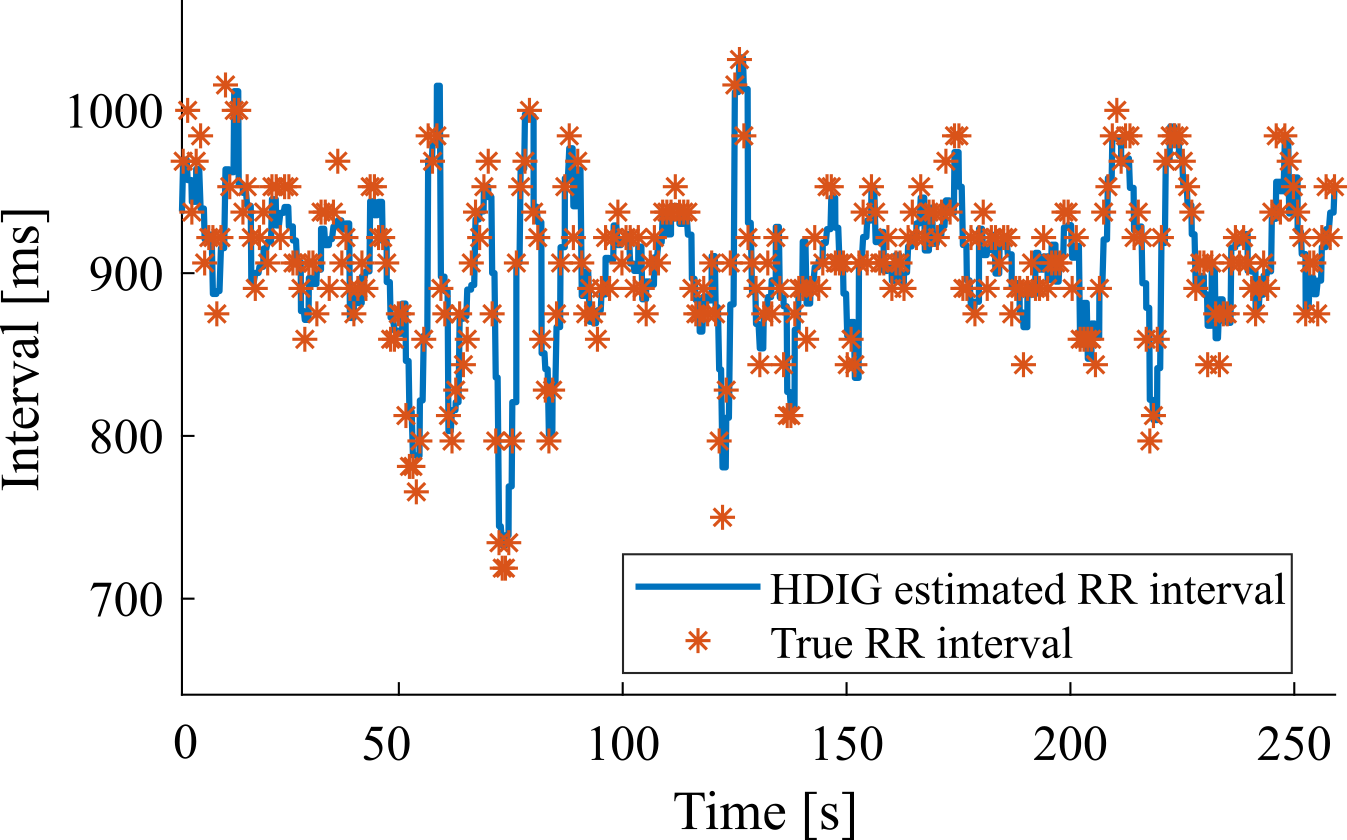
Wearable devices for physiological vital signal measurement
Published in Springer Publication, 2010
Recommended citation: Nakagome S, Craik A, Ravindran AS, He Y, Cruz‐Garza JG, and Contreras‐Vidal JL. Springer Handbook of Neuroengineering. In: ed. by Thakor NV. Springer Nature. Chap. Deep learning methods for EEG neural classification. In Press
Published in Annual International Conference of the IEEE Engineering in Medicine and Biology Society (EMBC), 2016
Recommended citation: Preejith, S. P., Ravindran, A. S., Hajare, R., Joseph, J., & Sivaprakasam, M. (2016, August). A wrist worn SpO 2 monitor with custom finger probe for motion artifact removal. In 2016 38th Annual International Conference of the IEEE Engineering in Medicine and Biology Society (EMBC) (pp. 5777-5780). IEEE.
Published in Journal of Neural Engineering, 2019
Recommended citation: Ravindran, A. S., Mobiny, A., Cruz-Garza, J. G., Paek, A., Kopteva, A., & Vidal, J. L. C. (2019). Assaying neural activity of children during video game play in public spaces: a deep learning approach. Journal of neural engineering, 16(3), 036028.
Published in 2019 IEEE Healthcare Innovations and Point of Care Technologies, (HI-POCT), 2019
Recommended citation: Ravindran, A. S., Nakagome, S., Wickramasuriya, D. S., Contreras-Vidal, J. L., & Faghih, R. T. (2019, November). Emotion recognition by point process characterization of heartbeat dynamics. In 2019 IEEE Healthcare Innovations and Point of Care Technologies,(HI-POCT) (pp. 13-16). IEEE.
Published in Scientific reports, 2020
Recommended citation: Nakagome, S., Luu, T. P., He, Y., Ravindran, A. S., & Contreras-Vidal, J. L. (2020). An empirical comparison of neural networks and machine learning algorithms for EEG gait decoding. Scientific reports, 10(1), 1-17.
Published in 2020 IEEE International Conference on Systems, Man, and Cybernetics (SMC), 2020
Recommended citation: Ravindran, A. S., Cestari, M., Malaya, C., John, I., Francisco, G. E., Layne, C., & Vidal, J. L. C. (2020, October). Interpretable Deep Learning Models for Single Trial Prediction of Balance Loss. In 2020 IEEE International Conference on Systems, Man, and Cybernetics (SMC) (pp. 268-273). IEEE.
Published in Frontiers in human neuroscience, 2020
Recommended citation: Cruz-Garza, J. G., Sujatha Ravindran, A., Kopteva, A. E., Rivera Garza, C., & Contreras-Vidal, J. L. (2020). Characterization of the Stages of Creative Writing With Mobile EEG Using Generalized Partial Directed Coherence. Frontiers in human neuroscience, 14, 533.
Published in IEEE open journal of engineering in medicine and biology, 2021
Recommended citation: Paek, A. Y., Brantley, J. A., Ravindran, A. S., Nathan, K., He, Y., Eguren, D., ... & Contreras-Vidal, J. L. (2021). A Roadmap towards Standards for Neurally Controlled End Effectors. IEEE open journal of engineering in medicine and biology, 2.